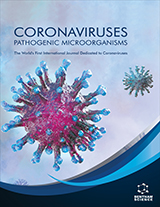Abstract
The novel coronavirus severe acute respiratory syndrome Corona Virus-2 (SARS-CoV- -2) has become a pandemic, as declared by WHO in March 2020 producing deleterious effects on patients worldwide. The angiotensin-converting enzyme-2 (ACE-2) has been recognized as the coreceptor for SARS-CoV-2 infections and may act as a therapeutic step in blocking the enzyme to reduce SARS-CoV-2 expression and further cellular entry. Presently, the role of ACE-2 in coronavirus disease 2019 (COVID-19) infection has been known and the experts have started working on the enzyme ACE-2 for the management and treatment of this pandemic disease. The binding of spike (S) protein of SARS-CoV-2 to these receptors is the most important step and plays a key role in viral replication, thus this enzyme is becoming the doorway for the entry and spread in the human body causing asymptomatic pneumonia and severe of which is leading to death. As no specific method to prevent and treat this disease is available, the use of ACE-2 as a targeting ligand with COVID-19 virus spike protein could be helpful in the proper management of SARS-CoV-2 pneumonia.
Keywords: ACE-2, COVID-19, SARS-CoV-2, TMPRSS2, Furin, ligand.
Graphical Abstract
Coronaviruses
Title:Angiotensin Converting Enzyme-2: A Doorway for SARS-CoV-2
Volume: 2 Issue: 12
Author(s): Vikas Pandey, Indu Lata Kanwar, Tanweer Haider, Vishal Gour, Monika Vishwakarma, Avijit Kumar Bakshi, Ravishankar Yadav and Vandana Soni*
Affiliation:
- Department of Pharmaceutical Sciences, Dr. Harisingh Gour University, Sagar, Madhya Pradesh,India
Keywords: ACE-2, COVID-19, SARS-CoV-2, TMPRSS2, Furin, ligand.
Abstract: The novel coronavirus severe acute respiratory syndrome Corona Virus-2 (SARS-CoV- -2) has become a pandemic, as declared by WHO in March 2020 producing deleterious effects on patients worldwide. The angiotensin-converting enzyme-2 (ACE-2) has been recognized as the coreceptor for SARS-CoV-2 infections and may act as a therapeutic step in blocking the enzyme to reduce SARS-CoV-2 expression and further cellular entry. Presently, the role of ACE-2 in coronavirus disease 2019 (COVID-19) infection has been known and the experts have started working on the enzyme ACE-2 for the management and treatment of this pandemic disease. The binding of spike (S) protein of SARS-CoV-2 to these receptors is the most important step and plays a key role in viral replication, thus this enzyme is becoming the doorway for the entry and spread in the human body causing asymptomatic pneumonia and severe of which is leading to death. As no specific method to prevent and treat this disease is available, the use of ACE-2 as a targeting ligand with COVID-19 virus spike protein could be helpful in the proper management of SARS-CoV-2 pneumonia.
Export Options
About this article
Cite this article as:
Pandey Vikas , Kanwar Lata Indu , Haider Tanweer, Gour Vishal , Vishwakarma Monika , Bakshi Kumar Avijit , Yadav Ravishankar and Soni Vandana*, Angiotensin Converting Enzyme-2: A Doorway for SARS-CoV-2, Coronaviruses 2021; 2 (12) : e070921191639 . https://dx.doi.org/10.2174/2666796702666210222110044
| DOI https://dx.doi.org/10.2174/2666796702666210222110044 |
Print ISSN 2666-7967 |
| Publisher Name Bentham Science Publisher |
Online ISSN 2666-7975 |
 10
10
- Author Guidelines
- Graphical Abstracts
- Fabricating and Stating False Information
- Research Misconduct
- Post Publication Discussions and Corrections
- Publishing Ethics and Rectitude
- Increase Visibility of Your Article
- Archiving Policies
- Peer Review Workflow
- Order Your Article Before Print
- Promote Your Article
- Manuscript Transfer Facility
- Editorial Policies
- Allegations from Whistleblowers
- Announcements
Related Articles
-
Cholesterol Ester Transfer Protein (CETP), Postprandial Lipemia and Hypolipidemic Drugs
Current Medicinal Chemistry Pharmacologic Treatment for Prehypertension: To Treat or Not to Treat?
Recent Patents on Cardiovascular Drug Discovery Efficacy of Pentoxifylline in the Management of Microalbuminuria in Patients with Diabetes
Current Diabetes Reviews Polycystic Ovary Syndrome and Infertility: From Molecular Perspective
Current Women`s Health Reviews Chronic Latent Magnesium Deficiency in Obesity Decreases Positive Effects of Vitamin D on Cardiometabolic Risk Indicators
Current Vascular Pharmacology Solvent-Drop Grinding Method: Efficient Synthesis, DPPH Radical Scavenging and Anti-diabetic Activities of Chalcones, bis-chalcones, Azolines, and bis-azolines
Current Organic Synthesis The Pharmacological Management of Intrahepatic Cholestasis of Pregnancy
Current Clinical Pharmacology The Complexity of Aging: Cancer Risk Among Elderly People and Infectious Risk Among Those with Cancer
Anti-Cancer Agents in Medicinal Chemistry A Comprehensive Analysis of Unique and Recurrent Copy Number Variations in Alzheimer’s Disease and its Related Disorders
Current Alzheimer Research Ligand-Based Pharmacophore Detection, Screening of Potential Gliptins and Docking Studies to Get Effective Antidiabetic Agents
Combinatorial Chemistry & High Throughput Screening Choosing a Revascularization Strategy in Patients with Diabetes and Stable Coronary Artery Disease: A Complex Decision
Current Cardiology Reviews The Role of White Matter Abnormalities in Treatment-Resistant Depression: A Systematic Review
Current Pharmaceutical Design Polycystic Ovary Syndrome: A Contemporary Clinical Approach
Current Pharmaceutical Design Prophylactic Neuroprotection
Current Drug Targets Antiplatelet and Anticoagulation Strategies in the Prevention and Treatment of Ischemic Stroke
Current Pharmaceutical Design Repaglinide and Metformin-Loaded Amberlite Resin-Based Floating Microspheres for the Effective Management of Type 2 Diabetes
Current Drug Delivery Editorial (Thematic Issue: Modifying Cardiovascular Risk Factors: Current Opinion and Future Trends)
Current Pharmaceutical Design The Effectiveness of Nurse- and Pharmacist-Directed Care in Diabetes Disease Management:A Narrative Review
Current Diabetes Reviews Alternative Medicine as a Treatment Option for COVID-19
Current Traditional Medicine High-dose Vitamin D Supplementation on Type 1 Diabetes Mellitus Patients: Is there an Improvement in Glycemic Control?
Current Diabetes Reviews


























